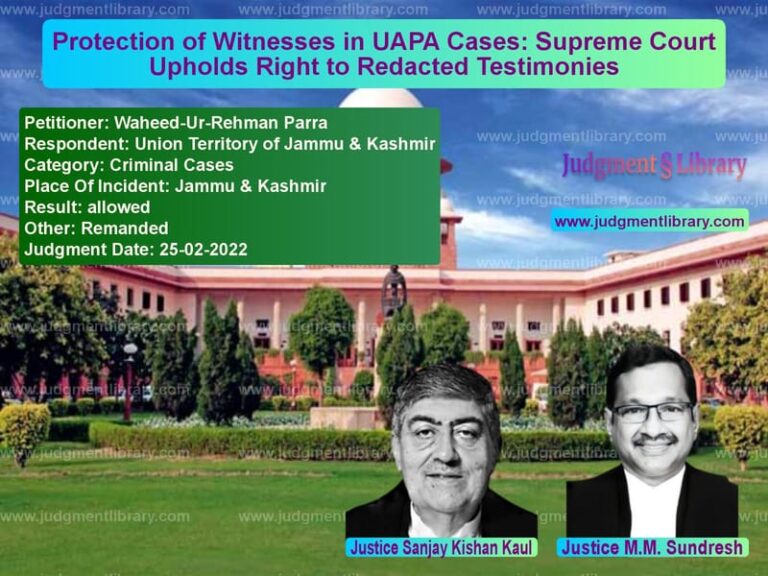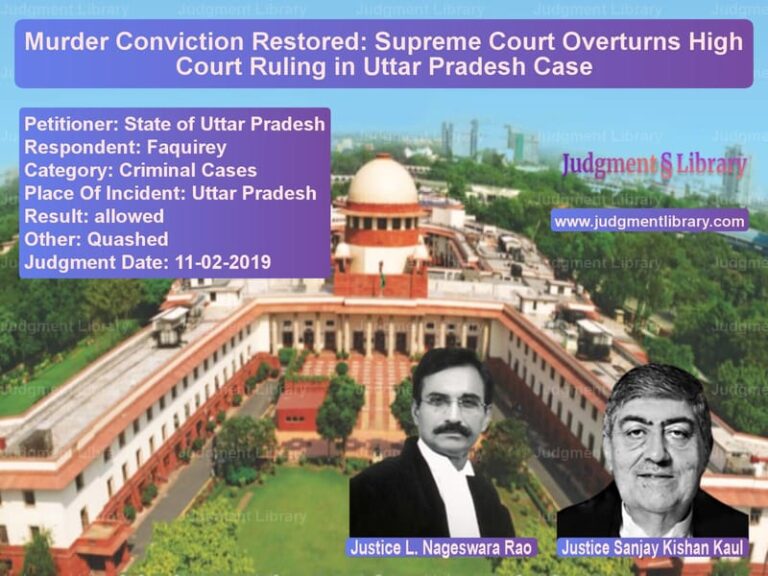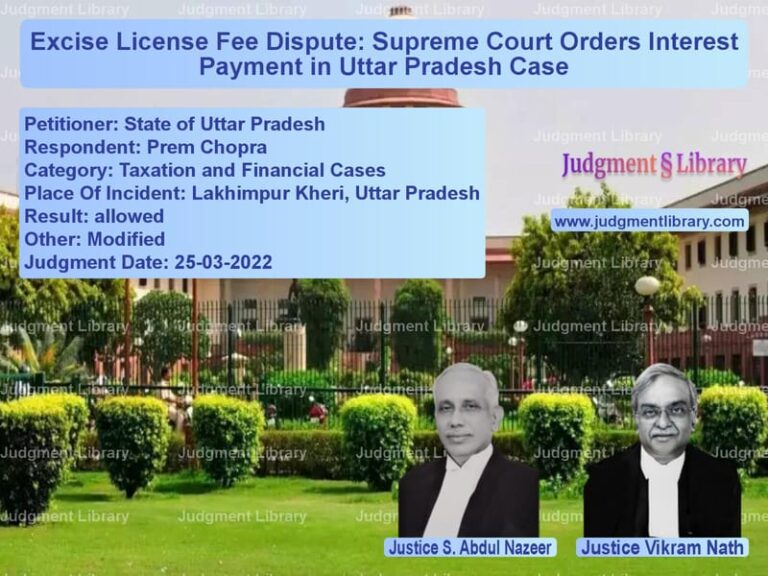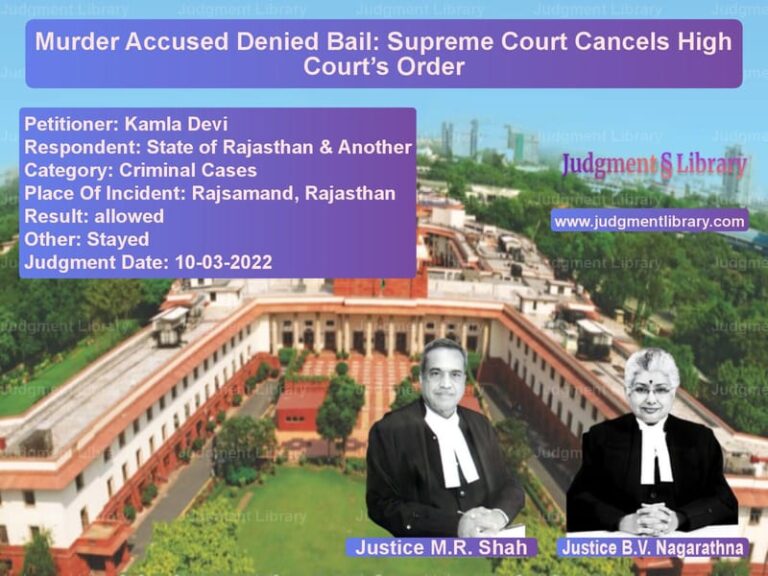Murder Conviction Reduced to Culpable Homicide: A Legal Analysis
The Supreme Court of India, in the case of Sabitri Samantaray & Anr. v. State of Odisha, delivered a crucial judgment on May 20, 2022. This case, arising from an appeal against the conviction under Section 302 of the Indian Penal Code (IPC), examines the extent of culpability in an alleged murder and the application of circumstantial evidence in criminal cases. The Court ultimately modified the conviction from murder to culpable homicide not amounting to murder under Section 304(II) IPC. This detailed analysis aims to break down the arguments, legal principles, and reasoning behind the verdict.
Background of the Case
The case revolves around the death of Sanjay Rana, a man found dead inside the house of the appellants, Sabitri Samantaray and Bidyadhar Praharaj, in Odisha. The prosecution’s case was built on circumstantial evidence, primarily linking the deceased’s presence in the accused’s house and forensic evidence pointing towards strangulation and acid burns. The defense maintained that they were victims of an armed intrusion and were unfairly implicated.
Facts Leading to the Incident
The appellants, a married couple, were tenants in the house of one Mayadhar Mohapana. On July 21, 2008, an incident occurred wherein the landlord claimed to have heard distressing noises from the appellants’ rented portion of the house. Upon intervention, he witnessed an unknown person allegedly attacking the appellants with a weapon. As neighbors gathered, the appellants were rescued through an inter-connected door, but the unknown person remained inside. Upon the police’s arrival, a dead body was discovered inside the kitchen. Initially suspected to be a suicide, a subsequent post-mortem revealed homicidal strangulation injuries.
Prosecution’s Case
The prosecution argued that the deceased had an ongoing relationship with the appellants’ daughter, accused no. 3 in the case. Witnesses testified that he had given money to her, expecting marriage, but faced rejection after she secured employment at a bank. On the day of his death, he had visited their house with the intent of either marrying her or retrieving his money. The prosecution contended that the appellants, upon confrontation with the deceased, overpowered him, strangled him to death, and poured acid over his body to impede identification.
Key evidentiary points presented by the prosecution:
- The deceased was last seen entering the house of the appellants.
- Post-mortem findings confirmed death by strangulation and acid burns.
- Witness testimonies established a motive based on the financial and romantic relationship between the deceased and the appellants’ daughter.
- The presence of the appellants in the house at the time of the incident suggested they had exclusive knowledge of the circumstances leading to the death.
Defense’s Arguments
The appellants denied all allegations, asserting that they were victims of an intrusion. They claimed that an unknown assailant entered their house forcibly, locked it from inside, and attacked them, leading to their injuries. They maintained that the deceased was not known to them and that his presence inside the house was inexplicable.
The defense raised several crucial points:
- The prosecution’s case was based purely on circumstantial evidence, with no direct witnesses.
- The post-mortem report suggested injuries that could be inconsistent with the prosecution’s timeline.
- The reliance on the appellants’ Section 313 CrPC statements was inappropriate, as such statements cannot be treated as substantive evidence.
High Court’s Judgment
The High Court, while acknowledging the circumstantial nature of the evidence, observed that the appellants were the only individuals present inside the house at the time of the incident. It further noted:
- The prosecution had successfully established a motive for the crime.
- Statements from witnesses indicated the deceased’s intentions on the day of his death.
- The appellants’ defense failed to offer a plausible alternative explanation for the death.
However, considering the possibility of a sudden provocation, the High Court reduced the conviction from murder (Section 302 IPC) to culpable homicide not amounting to murder (Section 304(II) IPC), thereby reducing the sentence to five years of rigorous imprisonment.
Supreme Court’s Analysis and Final Verdict
The Supreme Court upheld the High Court’s judgment. The Court analyzed the application of Section 106 of the Evidence Act, which states that when an individual has exclusive knowledge of the facts leading to an event, the burden of proof shifts to them to provide an explanation.
Observations by the Supreme Court:
- The circumstantial evidence strongly pointed to the appellants’ involvement.
- Their failure to offer a reasonable explanation regarding the deceased’s presence and death within their house justified an inference of guilt.
- The High Court’s modification of the charge was appropriate, considering the presence of sudden provocation.
The Supreme Court thus dismissed the appeal and directed the appellants to surrender to serve their sentence.
Legal Principles Involved
The case highlights critical principles in criminal jurisprudence:
- Burden of Proof: While the prosecution carries the initial burden, Section 106 of the Evidence Act allows the burden to shift to the accused in cases where exclusive knowledge exists.
- Circumstantial Evidence: Courts rely on circumstantial evidence when direct evidence is unavailable, provided the chain of events establishes guilt beyond reasonable doubt.
- Doctrine of Last Seen: If a person is last seen alive with an accused, and subsequently found dead, the burden shifts to the accused to explain what transpired.
- Role of Motive: Establishing motive strengthens the prosecution’s case, though the absence of motive does not automatically exonerate an accused.
Conclusion
This case exemplifies the nuanced approach courts take in distinguishing between murder and culpable homicide. The decision reinforces the principle that when an unnatural death occurs within a confined setting, the accused must provide a credible explanation. The Supreme Court’s ruling serves as a reminder of the importance of circumstantial evidence and the judicial balancing act required in criminal cases.
Petitioner Name: Sabitri Samantaray and Bidyadhar Praharaj.Respondent Name: State of Odisha.Judgment By: Justice N.V. Ramana, Justice Krishna Murari, Justice Hima Kohli.Place Of Incident: Odisha.Judgment Date: 20-05-2022.
Don’t miss out on the full details! Download the complete judgment in PDF format below and gain valuable insights instantly!
Download Judgment: sabitri-samantaray-a-vs-state-of-odisha-supreme-court-of-india-judgment-dated-20-05-2022.pdf
Directly Download Judgment: Directly download this Judgment
See all petitions in Murder Cases
See all petitions in Bail and Anticipatory Bail
See all petitions in Attempt to Murder Cases
See all petitions in Fraud and Forgery
See all petitions in Judgment by N.V. Ramana
See all petitions in Judgment by Krishna Murari
See all petitions in Judgment by Hima Kohli
See all petitions in dismissed
See all petitions in supreme court of India judgments May 2022
See all petitions in 2022 judgments
See all posts in Criminal Cases Category
See all allowed petitions in Criminal Cases Category
See all Dismissed petitions in Criminal Cases Category
See all partially allowed petitions in Criminal Cases Category







